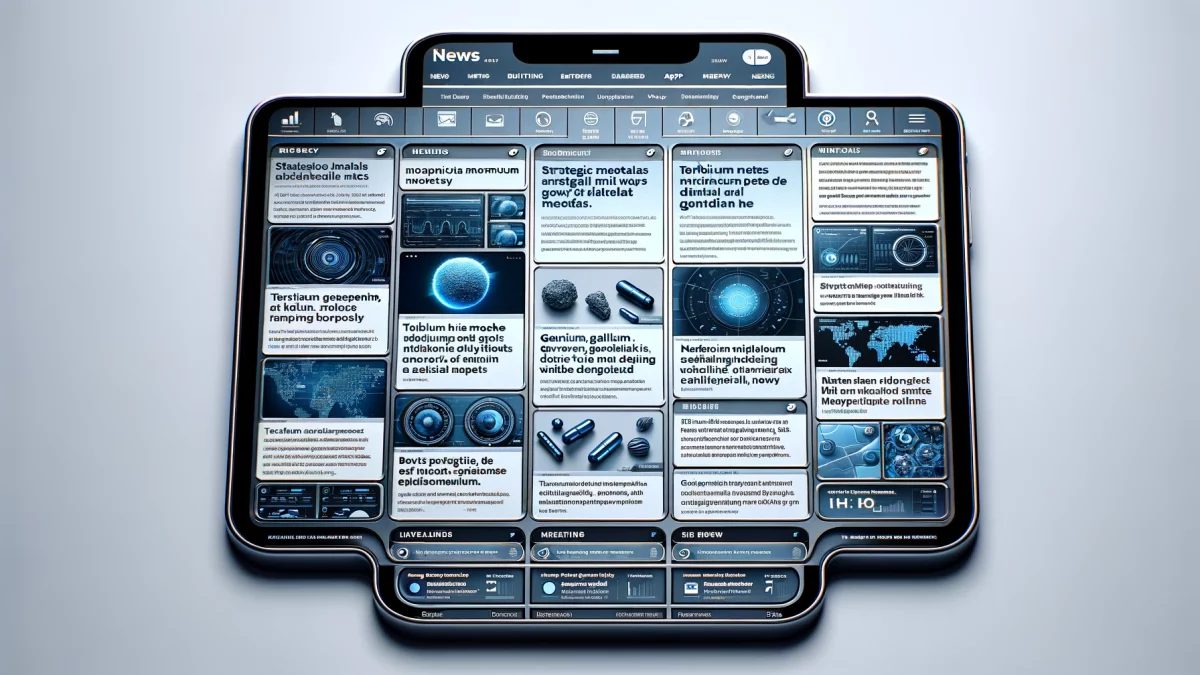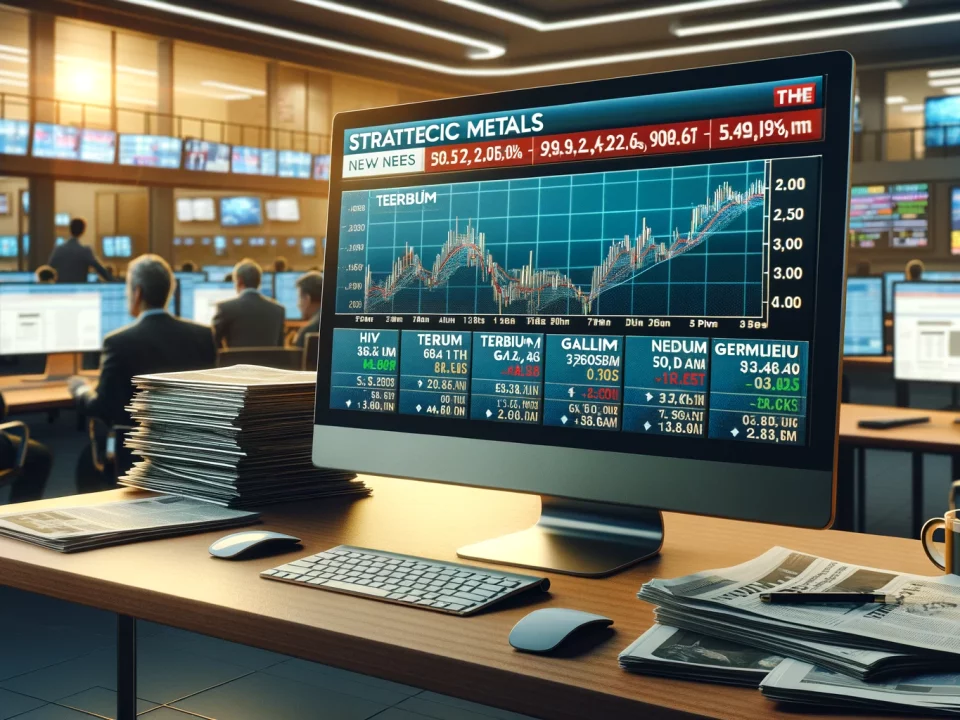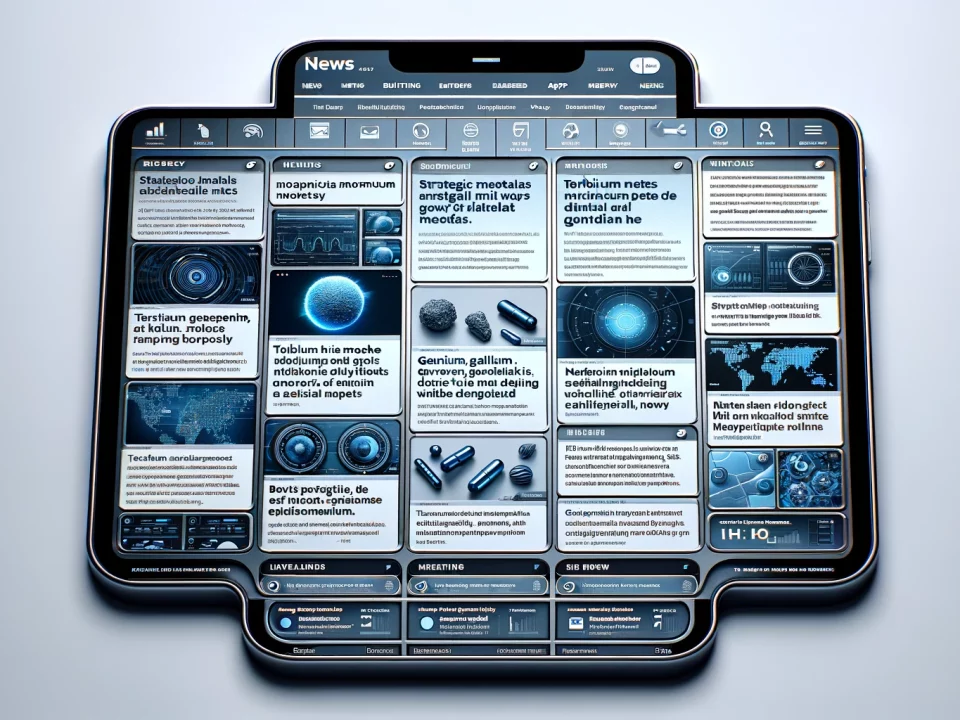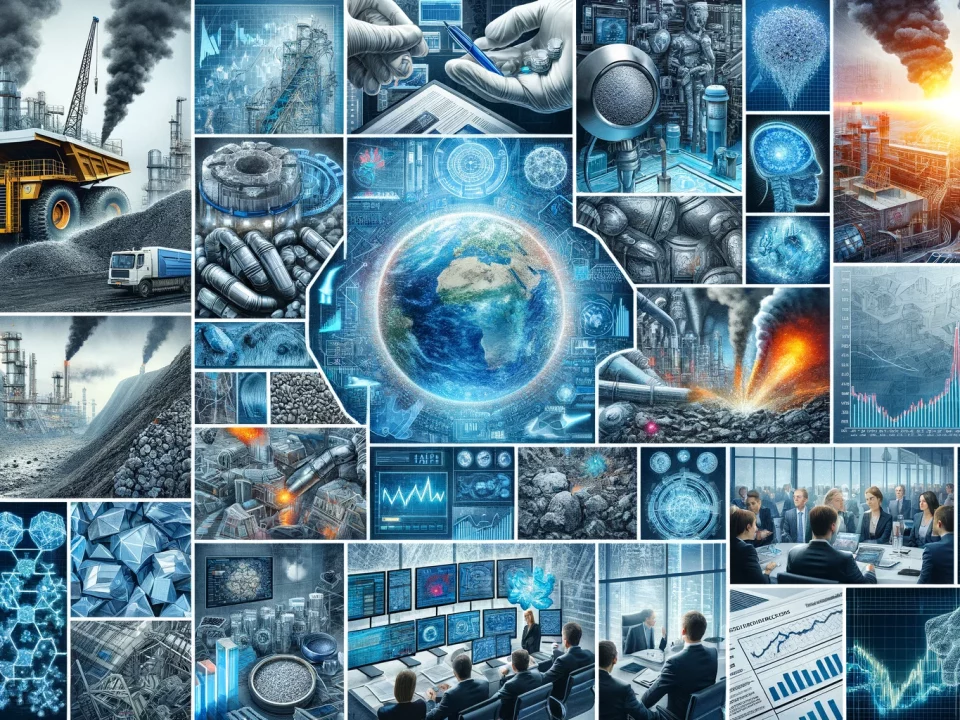
Weekly News Review August 26 – September 1 2024
September 1, 2024
Strategic Metals Market Insight: The 2024 US Election Impact
September 11, 2024Welcome to our weekly news review.
USA IMPLEMENTS EXPORT CONTROLS FOR SEMICONDUCTOR TECHNOLOGY AND QUANTUM COMPUTING:
Effective September 5th, exports of certain advanced technologies and equipment require licenses.
The United States Department of Commerce has published an interim final rule implementing export controls on various advanced technologies. The goods affected by the measure are related to quantum computing, semiconductor manufacturing, Gate All-Around Field-Effect Transistor (GAAFET) Technology, and additive manufacturing. Effective today, individuals wishing to export equipment, components, materials, software, and technologies used in these fields require official licenses.
The BIS also published a list of countries exempt from these requirements, depending on the category. It includes countries like Germany, Italy, and the United Kingdom.
In a statement, the Department’s Bureau of Industry and Security (BIS) justified the move on national security and foreign policies. “Today’s action ensures our national export controls keep in step with rapidly evolving technologies and are more effective when we work in concert with international partners,” said Alan Estevez, Under Secretary for the Bureau of Industry and Security.
According to Reuters, multiple countries, including the UK, have already implemented similar measures.
USA: MINING OF ANTIMONY WITHIN REACH –
A mine in Idaho could reduce dependence on China; export restrictions on the metalloid will soon apply.
Antimony could soon be mined again in the United States. That is according to Perpetua Resources, the operator of the Stibnite mine in Idaho, who expects government approval for its project to come by the end of the year. According to a press release, the United States Forest Service is expected to publish the necessary environmental impact documents as early as Friday. Although the mine’s namesake is the mineral stibnite, also known as antimony glance or gray antimony in German, the focus will be on gold extraction. Nearly five million ounces could be produced annually, making antimony mining economically viable.
Mining in Stibnite began as early as 1899, but it was done without regard for the environment for a long time. Therefore, part of Perpetua Resources’ concept is to rehabilitate the site. The necessary studies have been funded with nearly $60 million by the US Department of Defense, as antimony is of central importance to the defense industry, including ammunition production. The U.S. Export-Import Bank (EXIM) could also support the project with a loan of up to $1.8 billion, as announced last April.
China, the most crucial antimony producer, has announced export restrictions for the raw material starting in mid-September (we reported), which will likely increase the importance of Perpetua’s project in Idaho.
US TO SPEND $7.3 BILLION ON RURAL CLEAN ENERGY PROJECTS:
Under the Inflation Reduction Act, the US ramps up renewables in rural regions.
The United States Government announced Thursday that it will allocate $7.3 billion from the Inflation Reduction Act (IRA) budget to finance clean energy projects in rural areas. According to a press statement by the White House, the investment in 16 projects will help bring clean energy to citizens across 23 states and make it more affordable while creating up to 4,500 jobs.
The first company to be awarded a part of the funding is Dairyland Power Cooperative in Wisconsin, which, together with $573 million in government funding, will leverage a total of $2.1 billion for solar and wind power installations. President Joe Biden is set to unveil the spending on Thursday in Wisconsin. The remaining 15 projects are still in the underwriting process to receive government support. They range from installing renewable energy capacities to battery energy storage implementation to carbon capture methods.
The IRA is one of the cornerstones of Biden’s presidency, allocating billions for climate spending over the next ten years through subsidies, tax credits, and loans. Enacted over two years ago, the act has since funded several projects in the renewables sector and catalyzed decarbonization efforts across the US. However, due to its U.S.-centric focus, it has also gathered criticism abroad. Last year, we looked back at its achievements in its first year.
PERU AND THE US SIGN MOU ON STRATEGIC METALS:
South America has significant reserves of various raw materials.
The US Department of State announced that the United States and Peru have signed a Memorandum of Understanding (MoU) on critical minerals. The signing took place A WEEK AGO in Peru’s capital, Lima, during Under Secretary Jose W. Fernandez’s trip throughout South America. Over the last week and a half, Fernandez visited Argentina, Ecuador, and Peru in search of new sources of critical minerals (we reported).
Following the signing of an MoU on critical minerals with his Argentinian counterpart and Ecuador’s entry to the Minerals Security Partnership Forum, Fernandez’s trip ended with the signing ceremony of the MoU in Peru. Under the agreement, the Department said that the US and Peru will enhance cooperation on critical mineral supply chains, resource sector governance, investment, and global supply chain security.
According to data from the US Geological Survey, Peru is the third largest silver producer worldwide, accounting for roughly 12 percent of the total global output in 2023. The member of the Andean community is also the world’s second-largest copper producer, surpassed only by its southern neighbor, Chile. Peru also accounts for significant global gold, lead, tin, and zinc production shares.
FROM TASMANIA TO LOUISIANA: FURTHER COOPERATION ON STRATEGIC METALS –
Working towards a supply chain from Australia to the United States.
Australia-based ABx Group and Canadian critical minerals company Ucore Rare Metals have signed a Memorandum of Understanding (MoU) to establish a rare earth supply chain from Australia to North America. Under the MoU, the two parties will work towards a binding offtake agreement for rare earth carbonate from ABx’s Tasmanian rare earth project to be shipped to Ucore’s separation facility, which is currently being constructed in Louisiana, United States.
Ucore is set to obtain a so-called “first right of refusal” for 50% of ABx’s annual volume for a minimum period of five years. In addition, the companies will explore potential investment opportunities for Ucore in the Tasmanian project.
Ucore has signed multiple supply deals recently to fuel its ambitions to establish a North American value chain for rare earths and supply its Louisiana facilities. The plant is set to start operations in the fourth quarter of 2025, with commercial operations scheduled to begin in the first half of 2026.
In July, the company signed a deal with Canadian recycler Cyclic Materials to offtake recycled mixed rare earth oxides (we reported). In addition, Ucore has also secured a significant share of the future output from Meteoric’s rare earth project in Brazil.
BRAZILIAN CRITICAL MINERALS SIGNS MOU WITH LATIN AMERICAS FIRST MAGNET MAKER:
Lab Fab’s second MoU with rare earth exploration companies.
Australia-based mining and exploration company Brazilian Critical Minerals (BCM) has signed a Memorandum of Understanding (MoU) with SENAI Regional Department of Minas Gerais, owner of Lab Fab (PDF). SENAI stands for Serviço Nacional de Aprendizagem Industrial, which roughly translates to National Service for Industrial Training.
The organization provides training for specialized workers in mining or chemical engineering fields. Lab Fab is developing Latin America’s first rare earth magnet production facility. Under the five-year agreement, the two sides will seek to outline supply agreements, joint research on supply chains, and other areas of cooperation, such as consultancy or training.
Lab Fab plans to begin the initial production stages later this year, with a targeted annual production of 100 tons of rare earth magnets. The magnet maker plans to double this within three years.
BCM is currently in the exploration stage of its Ema rare earth project in Northern Brazil. Ema is an ionic adsorption deposit in which ores are hosted in decomposed rocks formed by intense weathering, primarily found in tropical and subtropical areas. These clay deposits are mined mainly in Southern China and neighboring Myanmar.
However, multiple projects in Brazil seek to develop clay projects, which could make the Latin American country a major player in the industry. Fellow Australian miner Meteoric Resources is also developing such a deposit in Brazil (we reported).
In addition, Meteoric also signed a five-year MoU with the SENAI Regional Department of Minas Gerais over the offtake of rare earth raw materials.
However, despite signing two agreements with developers of Brazilian deposits, initial production at Lab Fab will use Chinese feedstock, according to a spokesperson for the magnet maker in a recent interview held by industry news and analysis provider Argus. Meteoric targets to start the first production steps in 2027, while BCM’s project is in the early exploration stages, with scoping studies and economic analysis due for completion later this year.
SOUTH KOREA AND AUSTRALIA BOLSTER COOPERATION ON STRATEGIC METALS:
The signing of an MoU with Western Australia and discussions with Northern Australia.
The two countries announced Monday that they will deepen their ties on critical minerals and clean energy. The announcement comes amid South Korean Trade Minister Inkyo Cheong’s visit to Perth, Western Australia, to attend ceremonies commemorating the tenth anniversary of the Australia-South Korea free trade agreement and high-level business meetings afterward.
Cheong began the trip by signing a Memorandum of Understanding (MoU) with Western Australia’s Premier Roger Cook over critical minerals and clean energy. Western Australia is the country’s largest state. It is rich in natural resources and has a high potential for clean energy production. For example, Lynas, the world’s largest rare earth producer outside China, mines raw materials and is constructing a refining plant there. In addition, the state accounts for most of Australia’s total lithium production (PDF).
Besides signing the MoU, Cheong will also discuss cooperation on liquefied natural gas (LNG), critical minerals, and carbon capture and storage with Madeleine King, Australia’s Minister for Resources and North Australia. Finally, Cheon will attend the 45th Korea-Australia Economic Cooperation Committee (ECCC) meeting and the Korea-Australia Annual Trade Ministers’ Meeting.
South Korea Seeking to Strengthen Its Critical Mineral Supply Chains:
South Korea continuously seeks international partnerships on critical minerals as its high-tech semiconductor and electric vehicle production industry relies on a steady supply. Currently, the country depends mainly on imports from China, an industry leader. Over the weekend, the Korea Mine Rehabilitation and Mineral Resources Corporation (KOMIR) signed an agreement with the German Federal Institute for Geosciences and Natural Resource (BGR) to enhance cooperation on issues related to the supply of critical raw materials along the value chain, mining impacts, and raw material recycling.
In a social media post, BGR President Prof. Dr. Ralph Watzel said he had “a fascinating conversation” with KOMIR Vice President Dr. Soonjin Alex Kwon, and the first activities would be in talks already.
CANADA TO RAMP UP CRITICAL MINERAL RECYCLING IN ONTARIO:
Cyclic Materials and Green Graphite Technologies receive $6 million in funding.
The Canadian Government seeks to boost domestic recycling of critical minerals by awarding two companies in Ontario a total of $6 million (CAD$8.4 million). Cyclic Materials, a recycling company mainly focusing on the recovery of rare earth elements, will use the funding to advance the construction of a demonstration plant to produce mixed rare earth oxide and cobalt–nickel mixed hydroxide from recycled materials. Green Graphite Technologies on the other hand, specializes in the recovery of its namesake, graphite, from various sources to produce battery-grade graphite.
The investments cover a wide array of end products that could be supplied by recycled sources. While rare earth elements, such as permanent magnets, are used in wind turbines, electric vehicles, and electronics, battery-grade graphite is mainly used to produce lithium-ion batteries but also has some applications in solar panels.
Cyclic Materials has made headlines recently by signing multiple overseas supply agreements. The company inked a deal with UK-based vehicle salvaging company Synetiq, which will supply Cyclic Materials with EV and auxiliary motors in all cars. Cyclic Materials will then recover the magnets from these motors and extract a rare earth oxide mixture.
The second deal, signed with Solvay, sees Cyclic Materials supplying the chemical company with the rare earth oxides mix for Solvay to separate and refine into individual rare earths that can eventually resupply the European automotive industry.
SWEDEN: VATTENFALL AIMS TO RECYCLE 100% OF PERMANENT MAGNETS –
Decommissioned materials from the energy company’s wind farms will be fully reintegrated into the circular economy starting in 2030.
Swedish energy company Vattenfall plans to recycle 100 percent of rare earth permanent magnets from its wind farms in the future. According to a press statement, the initiative will take effect in 2030 for decommissioned wind turbines. Vattenfall aims to limit waste, improve the supply of rare earths, and reduce dependence on imports, which aligns with the EU’s Critical Raw Materials Act. This act aims to cover 25 percent of Europe’s strategic raw material needs through recycling by 2030.
While most recyclable material is expected to become available in the mid-2030s, Vattenfall emphasizes the need to develop efficient circular economy processes. The energy provider has established two partnerships: with Caremag, which is building a rare earth-focused permanent magnet recycling facility in France, and with Canadian recycler Cyclic Materials, which already collaborates with various European companies.
This is not Vattenfall’s first project of this kind. The company also works with Swedish automaker Volvo and mining company LKAB to create more sustainable supply chains. However, a recent study by the German Raw Materials Agency (DERA) highlighted the challenges facing large-scale recycling of rare earth magnets (we reported).
SWITZERLAND: HOW RUTHENIUM CAN BRING NEW LIFE TO PLASTIC WASTE –
A research team at ETH Zurich is developing methods for the chemical breakdown of plastics using ruthenium.
According to the United Nations, plastic pollution is one of the biggest environmental problems, with 400 million tons of plastic waste generated annually. Recycling and establishing a circular economy are essential solutions, alongside preventing new plastic waste. A research team at the Swiss Federal Institute of Technology (ETH) Zurich may have now made a significant contribution in this direction.
Currently, plastic waste is recycled mechanically by shredding and then melting it. However, as the team explained in a press release, the quality of the resulting plastic products decreases with each recycling step.
As an alternative, methods are being developed to chemically break down long-chain plastic molecules—polymers—into their building blocks, monomers. These shorter-chain molecules could, for example, be used to produce gasoline, kerosene, or motor oil or could be further processed into new, high-quality plastics.
Targeted Recycling: Metal Catalyst and Stirring Method Are Crucial –
Researchers led by Javier Pérez-Ramírez, Professor of Catalysis Engineering, for the necessary breakdown of polymer chains, have made important groundwork. They studied the breakdown of polyethylene and polypropylene, which comprise 60 percent of plastic waste, using hydrogen together. This is introduced after the plastic is melted in a steel tank. The suitable powdered catalyst plays an important role, with the metal ruthenium proving suitable. According to the researchers, this allows them to control the formation of molecules of a specific desired chain length and minimize byproducts like methane or propane.
They also discovered that proper stirring—the right tool and speed—is crucial to ensuring that the catalyst powder and hydrogen can reach every part of the plastic melt, which is a thousand times more viscous than honey.
Their work resulted in a mathematical formula for the entire chemical recycling process with all its parameters, “the dream of every chemical engineer,” according to Pérez-Ramírez. For example, this formula could now be used by the entire scientific community to optimize the choice of catalyst further. The ETH Zurich team plans to focus on this next. Additionally, the developed principles are suitable for scaling the technology from the lab scale to large recycling plants in the future. lithium is also processed locally into batteries for electric cars, among other things.






